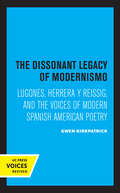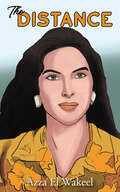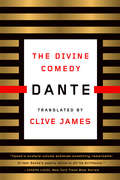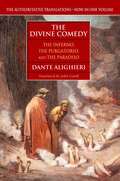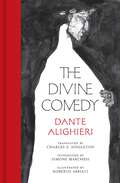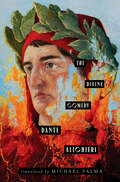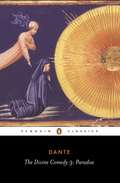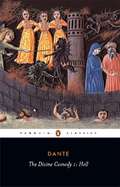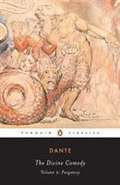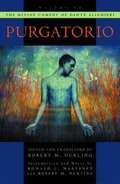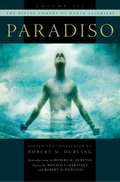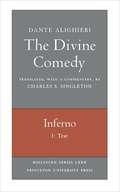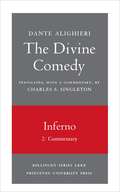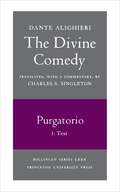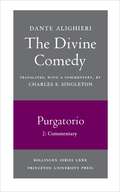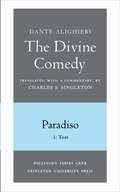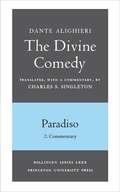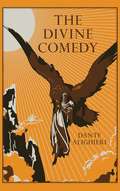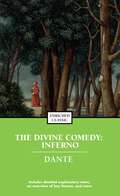- Table View
- List View
The Dissonant Legacy of Modernismo: Lugones, Herrera y Reissig, and the Voices of Modern Spanish American Poetry (Latin American Literature and Culture #3)
by Gwen KirkpatrickThis title is part of UC Press's Voices Revived program, which commemorates University of California Press’s mission to seek out and cultivate the brightest minds and give them voice, reach, and impact. Drawing on a backlist dating to 1893, Voices Revived makes high-quality, peer-reviewed scholarship accessible once again using print-on-demand technology. This title was originally published in 1989.
The Distance
by Azza El WakeelAt the age of eleven, Azza El Wakeel wrote in her diary that she wished to become a poetess because poets are capable of expressing their deep feelings and thoughts in a wonderful style. Several years later she discovered that her simple lines could be considered poems – that the texts in her diaries are poetry! All at once, she became a poetess and writer. Through writing she discovers herself and understands her feelings; she enjoys forming new sentences, playing with words, drawing images and composing inner music between the lines. Sharing her words makes her happy and she’s pleased to leave a mark of beauty on the earth, because she believes that poetry is the most beautiful thing in the world!
The Divine Comedy
by Dante Alighieri Clive James"Under James's uncanny touch, seven long centuries drop away, and the great poem is startlingly fresh and new."--Stephen Greenblatt The Divine Comedy is the precursor of modern literature, and Clive James's translation--decades in the making--gives us the entire epic as a single, coherent, and compulsively readable lyric poem. For the first time ever in an English translation, James makes the bold choice of switching from the terza rima composition of the original Italian--a measure that strains in English--to the quatrain. The result is "rhymed English stanzas that convey the music of Dante's triple rhymes" (Edward Mendelson). James's translation reproduces the same wonderful momentum of the original Italian that propels the reader along the pilgrim's path from Hell to Heaven, from despair to revelation.
The Divine Comedy
by Dante Alighieri John CiardiDante Alighieri's poetic masterpiece, The Divine Comedy, is a moving human drama, an unforgettable visionary journey through the infinite torment of Hell, up the arduous slopes of Purgatory, and on to the glorious realm of Paradise--the sphere of universal harmony and eternal salvation. 10 illustrations
The Divine Comedy
by Dante AlighieriFor the first time in one volume, the most elegant and accessible translation of Dante&’s enduring masterpieceCharles Singleton&’s English-language translation of The Divine Comedy is widely considered to be one of the finest renderings of Dante&’s masterpiece. Singleton&’s prose is both faithful and scholarly, and sensitive to the subtle nuances of meaning and richness of reference in Dante&’s epic poem. Here for the first time is the single-volume edition of Singleton&’s celebrated translation.This beautifully illustrated book brings together all three volumes of Dante&’s poem, describing his travels down to the circles of Hell, up over the mountain of Purgatory, and his ultimate ascension through the celestial spheres of Paradise. Dante&’s divine tour provides a timeless allegory for the journey of one&’s soul toward union with God.Featuring an incisive introduction by Simone Marchesi, a glossary, and stunning illustrations by acclaimed artist Roberto Abbiati, this handsome edition of The Divine Comedy introduces a new generation of readers to what is perhaps the preeminent achievement of Italian literature.
The Divine Comedy
by Dante Alighieri“If there is an afterexistence in which the individual human consciousness continues, I imagine Dante Alighieri is thanking the Creator for giving him, at last, a Michael Palma.” —Marilyn Nelson, author of A Wreath for Emmett Till When Michael Palma’s translation of the Inferno appeared in 2002, it defied the conventional wisdom of literary commentators who had long argued that Dante’s intricate terza rima form simply could not be rendered in “rhyme-poor” English. But Palma’s achievement in rhyming tercets was quickly received as a spectacular feat of poetic artistry that was “accurate... admirably clear, and readable” (Richard Wilbur) and that, “in capturing the sense, sound, and spirit of the original... comes close to perfection” (X. J. Kennedy). Now, more than two decades later, Palma has applied the same virtuosic attention to the form and flow of the Purgatorio and Paradiso, attending to both the tiniest details and the grand design of the entire Commedia and offering a fluid and readable English version that reveals to contemporary readers the sound, sense, and awe-inspiring beauty of Italian literature’s greatest poem.
The Divine Comedy & Paradise
by Dante AlighieriIn Paradise, having plunged to the uttermost depths of Hell and climbed the Mount of Purgatory, Dante ascends to Heaven, continuing his soul's search for God, guided by his beloved Beatrice. As he progresses through the spheres of Paradise he grows in understanding, until he finally experiences divine love in the radiant presence of the deity. Examining eternal questions of faith, desire and enlightenment, Dante exercised all his learning and wit, wrath and tenderness in his creation of one of the greatest of all Christian allegories.
The Divine Comedy - Hell
by Dante Alighieri Dorothy L. SayersGuided by the poet Virgil, Dante plunges to the very depths of Hell and embarks on his arduous journey towards God. Together they descend through the nine circles of the underworld and encounter the tormented souls of the damned - from heretics and pagans to gluttons, criminals and seducers - who tell of their sad fates and predict events still to come in Dante's life. In this first part of his Divine Comedy, Dante fused satire and humour with intellect and soaring passion to create an immortal Christian allegory of mankind's search for self-knowledge and spiritual enlightenment.
The Divine Comedy Volume II: Purgatory
by Dante AlighieriBeginning with Dante's liberation from Hell, Purgatory relates his ascent, accompanied by Virgil, of the Mount of Purgatory - a mountain of nine levels, formed from rock forced upwards when God threw Satan into depths of the earth. <p><p> As he travels through the first seven levels, Dante observes the sinners who are waiting for their release into Paradise, and through these encounters he is himself transformed into a stronger and better man. For it is only when he has learned from each of these levels that he can ascend to the gateway to Heaven: the Garden of Eden. <p><p> The second part of one of the greatest epic poems, Purgatory is an enthralling Christian allegory of sin, redemption and ultimate enlightenment.
The Divine Comedy of Dante Aligheri: Volume 2 Purgatorio
by Dante Alighieri Robert M. Durling Ronald L. MartinezIn the early 1300s, Dante Alighieri set out to write the three volumes which make the up The Divine Comedy. Purgatorio is the second volume in this set and opens with Dante the poet picturing Dante the pilgrim coming out of the pit of hell. Similar to the Inferno (34 cantos), this volume is divided into 33 cantos, written in tercets (groups of 3 lines). The English prose is arranged in tercets to facilitate easy correspondence to the verse form of the Italian on the facing page, enabling the reader to follow both languages line by line. In an effort to capture the peculiarities of Dante's original language, this translation strives toward the literal and sheds new light on the shape of the poem. Again the text of Purgatorio follows Petrocchi's La Commedia secondo l'antica vulgata, but the editor has departed from Petrocchi's readings in a number of cases, somewhat larger than in the previous Inferno, not without consideration of recent critical readings of the Comedy by scholars such as Lanza (1995, 1997) and Sanguineti (2001). As before, Petrocchi's punctuation has been lightened and American norms have been followed. However, without any pretensions to being "critical", the text presented here is electic and being not persuaded of the exclusive authority of any manuscript, the editor has felt free to adopt readings from various branches of the stemma. One major addition to this second volume is in the notes, where is found the Intercantica - a section for each canto that discusses its relation to the Inferno and which will make it easier for the reader to relate the different parts of the Comedy as a whole.
The Divine Comedy of Dante Alighieri: Volume 3 Paradiso
by Dante Alighieri Robert M. Durling Ronald L. MartinezRobert Durling's spirited new prose translation of the Paradiso completes his masterful rendering of the Divine Comedy. Durling's earlier translations of the Inferno and the Purgatorio garnered high praise, and with this superb version of the Paradiso readers can now traverse the entirety of Dante's epic poem of spiritual ascent with the guidance of one of the greatest living Italian-to-English translators.
The Divine Comedy, I. Inferno, Vol. I. Part 1: Text (Bollingen Series #677)
by DanteCharles S. Singleton's edition of the Divine Comedy, of which this is the first part, provides the English-speaking reader with everything he needs to read and understand Dante’s great masterpiece.The Italian text here is in the edition of Giorgio Petrocchi, the leading Italian editor of Dante. Professor Singleton’s prose translation, facing the Italian in a line-for-line arrangement on each page, is smooth and literate. The companion volume, the Commentary, marshals every point of information the reader may require: vocabulary; grammar; identification of Dante’s characters; historical sources of some of the incidents and, where pertinent, excerpts from those sources in their original languages and in translation; profound clear analysis of the Divine Comedy’s basic allegory. There is a complete bibliography of every aspect of Dante studies.This first part of the Divine Comedy which is illustrated with maps of Italy and the region Dante knew especially, diagrams of the circles of Hell, and plates showing some of the historic sites mentioned by Dante in his poem.
The Divine Comedy, I. Inferno, Vol. I. Part 2: Commentary (Bollingen Series #681)
by DanteCharles S. Singleton's edition of the Divine Comedy, of which this is the first part, provides the English-speaking reader with everything he needs to read and understand Dante’s great masterpiece.The Italian text here is in the edition of Giorgio Petrocchi, the leading Italian editor of Dante. Professor Singleton’s prose translation, facing the Italian in a line-for-line arrangement on each page, is smooth and literate. The companion volume, the Commentary, marshals every point of information the reader may require: vocabulary; grammar; identification of Dante’s characters; historical sources of some of the incidents and, where pertinent, excerpts from those sources in their original languages and in translation; profound clear analysis of the Divine Comedy’s basic allegory. There is a complete bibliography of every aspect of Dante studies.This first part of the Divine Comedy which is illustrated with maps of Italy and the region Dante knew especially, diagrams of the circles of Hell, and plates showing some of the historic sites mentioned by Dante in his poem.
The Divine Comedy, II. Purgatorio, Vol. II. Part 1: Text (Bollingen Series #675)
by DanteContinuing the paperback edition of Charles S. Singleton's translation of The Divine Comedy, this work provides the English-speaking reader with everything he needs to read and understand the Purgatorio. This volume consists of the prose translation of Giorgio Petrocchi's Italian text (which faces the translation on each page); its companion volume of commentary is a masterpiece of erudition, offering a wide range of information on such subjects as Dante's vocabulary, his characters, and the historical sources of incidents in the poem. Professor Singleton provides a clear and profound analysis of the poem's basic allegory, and the illustrations, diagrams, and map clarify points that have previously confused readers of The Divine Comedy.
The Divine Comedy, II. Purgatorio, Vol. II. Part 2: Commentary (Bollingen Series #676)
by DanteContinuing the paperback edition of Charles S. Singleton's translation of The Divine Comedy, this work provides the English-speaking reader with everything he needs to read and understand the Purgatorio. This volume consists of the prose translation of Giorgio Petrocchi's Italian text (which faces the translation on each page); its companion volume of commentary is a masterpiece of erudition, offering a wide range of information on such subjects as Dante's vocabulary, his characters, and the historical sources of incidents in the poem. Professor Singleton provides a clear and profound analysis of the poem's basic allegory, and the illustrations, diagrams, and map clarify points that have previously confused readers of The Divine Comedy.
The Divine Comedy, III. Paradiso, Vol. III. Part 1: 1: Italian Text and Translation; 2: Commentary (Bollingen Series #678)
by DanteContinuing the paperback edition of Charles S. Singleton's translation of The Divine Comedy, this work provides the English-speaking reader with everything he needs to read and understand the Paradiso. This volume consists of the prose translation of Giorgio Petrocchi's Italian text (which faces the translation on each page); its companion volume of commentary is a masterpiece of erudition, offering a wide range of information on such subjects as Dante's vocabulary, his characters, and the historical sources of incidents in the poem. Professor Singleton provides a clear and profound analysis of the poem's basic allegory, and the illustrations, diagrams, and map clarify points that have previously confused readers of The Divine Comedy.
The Divine Comedy, III. Paradiso, Vol. III. Part 2: Commentary (The Divine Comedy #6)
by DanteContinuing the paperback edition of Charles S. Singleton's translation of The Divine Comedy, this work provides the English-speaking reader with everything he needs to read and understand the Paradiso. This volume consists of the prose translation of Giorgio Petrocchi's Italian text (which faces the translation on each page); its companion volume of commentary is a masterpiece of erudition, offering a wide range of information on such subjects as Dante's vocabulary, his characters, and the historical sources of incidents in the poem. Professor Singleton provides a clear and profound analysis of the poem's basic allegory, and the illustrations, diagrams, and map clarify points that have previously confused readers of The Divine Comedy.
The Divine Comedy: Iii Paradise (Leather-bound Classics)
by Dante Alighieri Paul Gustave DoreInferno, Purgatorio, and Paradiso -- the three fates of the deceased become the three pillars of an epic poem. The Divine Comedy, written by Italian poet Dante Alighieri in the fourteenth century, is considered the foremost work in Italian literature. The journey begins with Dante's descent into the depths of Hell where he witnesses those eternally separated from God. Then he climbs the mountain of Purgatory where Christian souls undergo final purification, before finally touring the celestial circles of Heaven where he is filled with the image of God. An allegorical work, the comedy is representative of the soul's journey towards God.Influential for seven centuries, this classic is a must have for lovers of great literature, and the luxurious leather-bound edition from Canterbury Classics will make a stunning addition to any library.
The Divine Comedy: Inferno (Enriched Classics #2)
by DanteENDURING LITERATURE ILLUMINATED BY PRACTICAL SCHOLARSHIP The first volume of The Divine Comedy--Dante begins his downward journey through the seven circles of Hell. EACH ENRICHED CLASSIC EDITION INCLUDES: A concise introduction that gives readers important background information A chronology of the author's life and work A timeline of significant events that provides the book's historical context An outline of key themes and plot points to help readers form their own interpretations Detailed explanatory notes Critical analysis, including contemporary and modern perspectives on the work Discussion questions to promote lively classroom and book group interaction A list of recommended related books and films to broaden the reader's experience Enriched Classics offer readers affordable editions of great works of literature enhanced by helpful notes and insightful commentary. The scholarship provided in Enriched Classics enables readers to appreciate, understand, and enjoy the world's finest books to their full potential. SERIES EDITED BY CYNTHIA BRANTLEY JOHNSON
